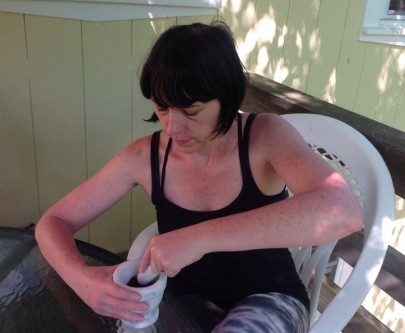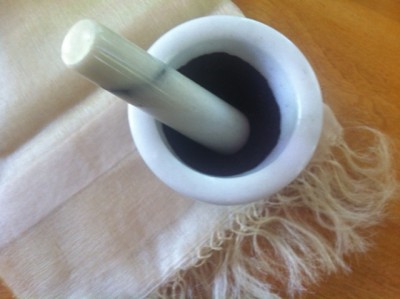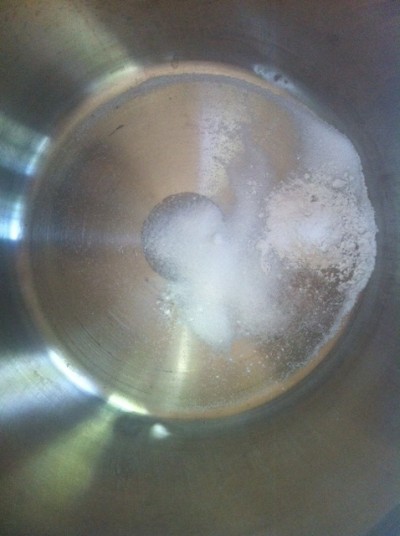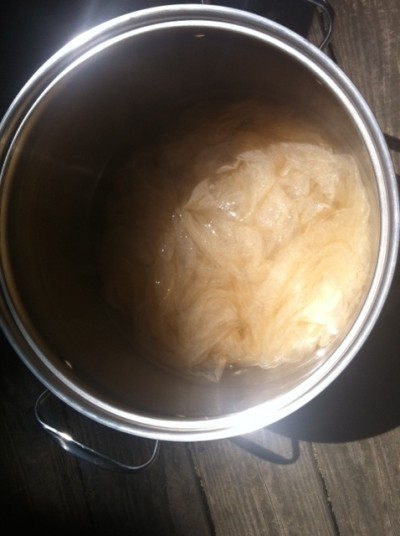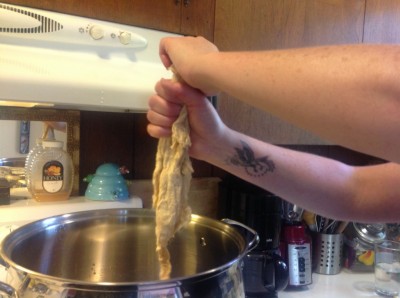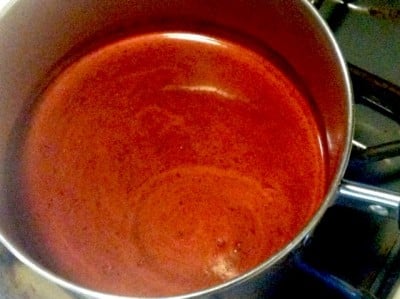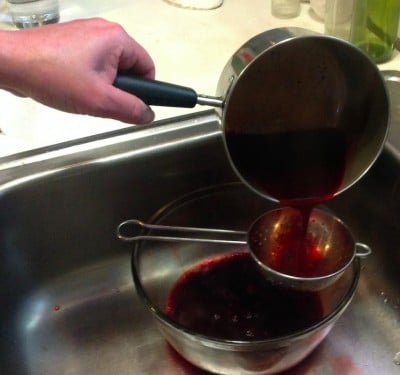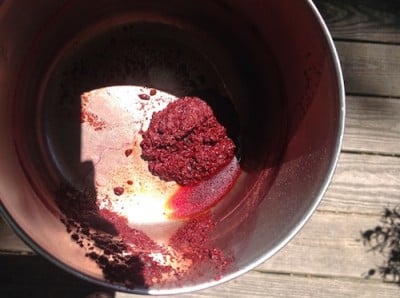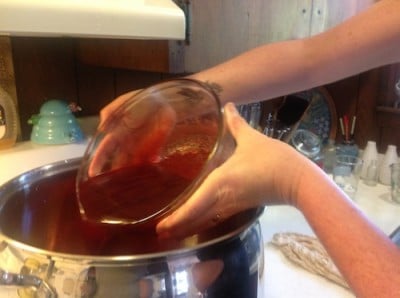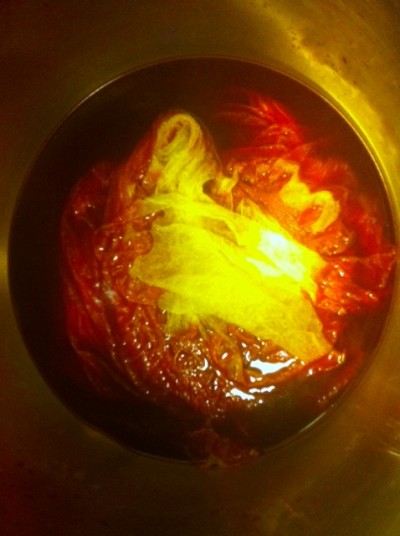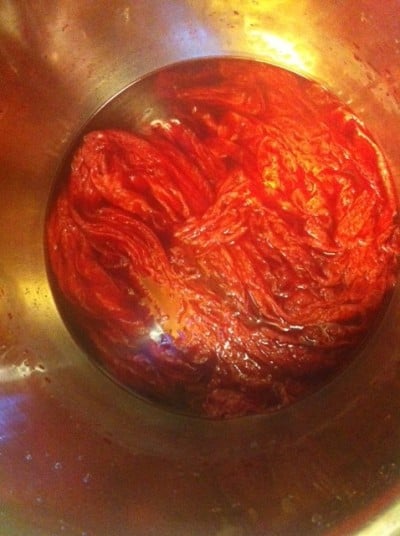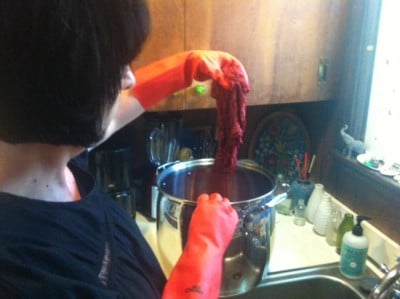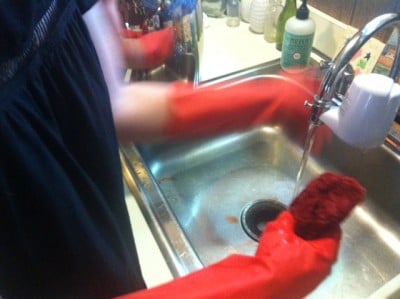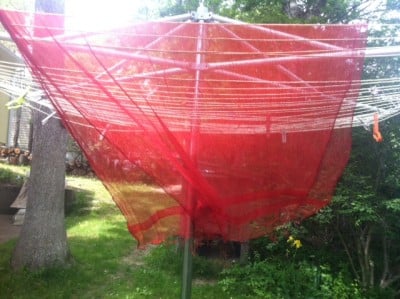Like I’ve said before, working for a natural dye guru like Kathy Hattori can give one an inferiority complex.
I hate inferiority complexes for me or anyone else, so when feeling less than, I say take on the thing that most scares you (unless it’s skiing). In this particular case, I accepted the challenge of cochineal and a Tussah Silk Gauze Shawl that is also on the Botanical Colors site.
In the instructions that Kathy gave me, it said to use a coffee grinder or spice mill to grind up 1 tablespoon of whole cochineal (for a dark red which I opted for). When I asked her if that ground up bug dust would then result in a much altered cup of coffee, she just answered “Don’t do it.”
So I grabbed a mortar and pestle I never use and worked hard to make a fine red pigment that eventually began to smell like hints of death warmed over.
Cochineal is a red dye consisting of dried female cochineal scale insects that feed on the nopal cactus, or prickly pear cacti, sucking moisture and nutrients from the flat prickly paddles.
They are a potent dye stuff and the source of a bright red due to the carbonic acid present in the dried insects, that was imported to Europe from Mexico and Peru. Kathy says a wonderful book to check out on the history of cochineal is A Perfect Red, by Amy Greenfield.
Mordanting
1. Dissolve 2 teaspoons of Alum in 32 ounces of water in a non-reactive dye pot. Kathy’s note: you won’t screw things up but rust will probably influence the color darker and slightly grayer.
2. Optionally, add 1/2 teaspoon Cream of Tartar to brighten color and help keep wool soft. (I totally did this.) Kathy’s note: it also turns cochineal from a fuchsia color to a Redcoat red.
3. Stir well to dissolve.
4. Add fibers to the dye pot and stir gently until heat gets to 180-200 degrees Fahrenheit (or, as Kathy says, little bubbles are consistently all around the edges and it’s quite steamy). Kathy’s note: Overenthusiastic stirring = tangled fringe
5. Hold at this temp for 45 minutes rotating occasionally and then allow to cool.
6. Remove fibers from dye pot, extract excess liquid gently, let cool and rinse briefly. You may also leave fibers to cool in the mordant bath overnight. Kathy’s note: Wear gloves as alum is drying. If you leave the fibers in overnight, make sure they are completely submerged in the alum liquid.
Bring.On.The.Bugs. (Or now…to dye)
1. So at this point I have already measured the Tablespoon of bugs and ground them up in said mortar and pestle.
2. Place the ground cochineal powder in 2 cups of water in a non-reactive (not rusty) sauce pan and bring to a boil. Add 1 teaspoon Cream of Tartar and boil for 10-15 minutes more.
3. Strain the colored dye solution into a non-reactive vessel (I used a glass Pyrex bowl), and reserve the bug residue.
4. Add more water and repeat step 2 until the bugs are no longer yielding much color (about 3-4 times). Compost the cochineal sludge.
5. The bright red liquid is your dye bath. Pour the dye bath into a dye pot and proceed to dyeing!!!
Dyeing
Kathy says you want the dye bath to be about 90 degrees Fahrenheit but if you see bubbles all around the edges, you’re good. This “low and slow” method helps keep your dye job nice and even.
Rotate the scarf gently and hold at this temp for about 20-30 minutes, then bring the temp up gradually to 180 degrees Fahrenheit (bigger bubbles along edges.)
While your textiles are soaking in all that cochineal goodness, make sure to rotate occasionally.
Let the scarf cool in the pot so you don’t burn your skin off then squeeze out excess dye liquid and rinse the dyed goods.
And then what???? Freak out over how cool you are that you just dyed something!!
And then of course get some nice cochineal/Botanical Colors-on-the-clothesline-porn for everyone to see.
Lovely right? I’m addicted.
4 questions I had for Kathy post-dyeing:
1. Could I have added more water to the mordant bath without diluting the mordant water if I’d had more stuff to dye? Yes. Duh.
2. Could I have added more water to the dye bath if I’d had more stuff to dye? Yes. Double duh.
3. Could I have saved my excess dye bath? Yes! In a mason jar in the fridge for about a week (make sure to label and date). Cochineal is very strong and will dye a lot more fiber. Use it until the dyebath is pale pink!
4. Could I have saved my excess mordant water? Yes! Again, in a bucket or jar, labeled, and add a 1/2 tsp more of the mordant to reawaken the bonding properties to their full potential the next time. Some dyers will reuse their mordant pots up to 6 or 7 times. When the liquid is cloudy or flaky, it’s time to change the mordant.
If I can do this, so can you! Send us your pictures and I’ll post them on our Facebook page because not only I but Kathy and thousands of others will be so proud of you.
Natural dyes forever.

